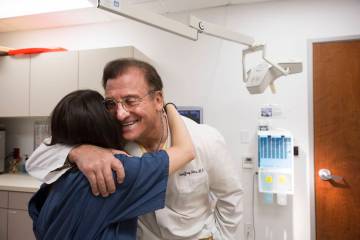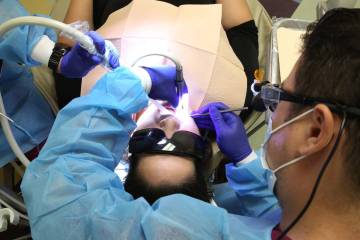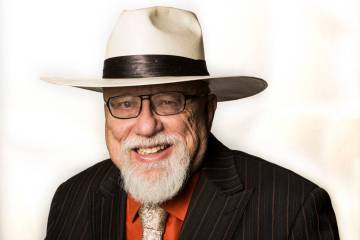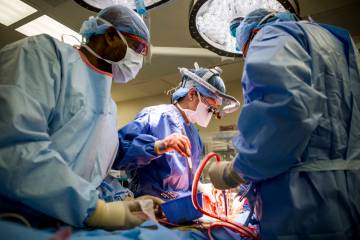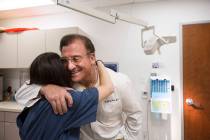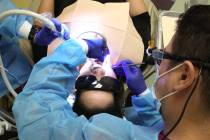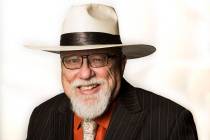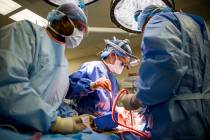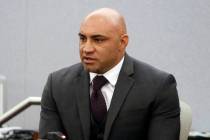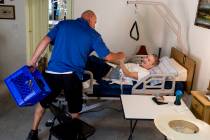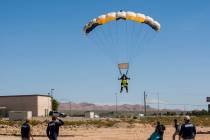Seeing the miracle of episodic analgesia
Dr. Jeff Moxley will never forget the scene in the University Medical Center trauma unit.
As Andrew Linn sat on a gurney with 4 to 6 inches of pole sticking out of his mouth and neck -- the 2-inch-diameter metal had been driven through his mouth and out through his neck in a Las Vegas auto accident, he took out his phone and began to text his wife about what had happened.
"He was very calm and didn't appear in any pain," said Moxley, an oral surgeon who was part of a trauma team led by surgeon Dr. Jay Coates. "At that point he hadn't been given any anesthetic. It's really kind of awesome, something in us that helps us get through horrific injuries."
What happened at UMC in the early morning hours of Nov. 29, 2010, is now the subject of an episode in "Untold Stories of the E.R.," a television series that airs on the Discovery Fit & Health and TLC cable channels. The next scheduled showing is at
9 p.m. Feb. 8 on TLC, with the shows often repeating on each channel.
The show recreates miraculous emergency room experiences. Moxley and Coates play themselves in the show, but an actor plays Linn's role.
"It just wasn't something I wanted to relive," Linn said last week.
After the Las Vegas Review-Journal reported last year on the accident that saw a medical team remove the pipe without causing the carotid artery and jugular vein to explode in a sea of blood, the story went viral, running across the globe, generally with the X-ray that showed the pipe both inside and outside Linn's skull.
Coates and Linn were flown from Las Vegas to New York to do the "Today Show." A specialist in dental reconstruction, Dr. Howard Abrahams of Miami Beach, Fla., saw the "Today Show" and made Linn a device that replaced six teeth lost in the accident.
Abrahams said he was impressed with the spirit of Linn, who escaped injury from explosives while he guarded military convoys with the Marines in Iraq.
"Marines go through hell for this country and I just wanted to thank him for what he did," he said.
Linn, a Las Vegas native who attends Southern Utah University, also had plastic surgery done on his lip through Veterans Affairs, as well as a shoulder reconstruction.
It is now difficult to tell that he was ever impaled. Through it all, he remains amazed that right after the accident -- he hit a chain- link fence with the pole atop the fence crashing through the front window and then through him -- he felt no pain.
"It's hard to understand," said Linn, who has no memory of the accident. Authorities theorize he fell asleep at the wheel.
Medical researchers and physicians agree that the state known as "episodic analgesia" -- where the patient is aware of the injury but feels no pain -- is puzzling.
Coates has seen the phenomenon before.
"I was treating a guy who had both arms torn off in an industrial accident and he was talking to me calmly about what happened as I started to treat him," Coates recalled.
Dr. Dale Carrison, head of emergency and chief of staff at UMC, had a patient who lost a leg in a motorcycle accident describing what happened. Incredibly, Carrison said, the patient winced at a shot but not at the pain from the lost leg.
And a woman who tried to commit suicide -- she shot herself in the head and lost an eye -- talked to Carrison normally about what she had done.
The onset of analgesia -- pain relief -- is instant, but lasts for a limited time. With extreme trauma, it is clear that the brain is capable of blocking out pain. It often happens on the battlefield as soldiers try to survive. But adding to the mystery of episodic analgesia, Carrison noted, is this -- "It doesn't happen for everybody. I'll have someone else screaming at the top of his lungs with the same injury."
Researchers say that when episodic analgesia occurs, part of the brain releases the body's natural painkillers, endorphins, which are thought to be more powerful than morphine.
When danger has passed and the injured party is safely getting treated, the endorphins generally fade away and the pain starts to intensify.
Linn said he has no idea how his brain knew to press the pause button on pain.
He's just glad it did.
Paul Harasim is the medical reporter for the Las Vegas Review-Journal. His column appears Mondays. Harasim can be reached at pharasim@reviewjournal.com or 702-387-2908.




